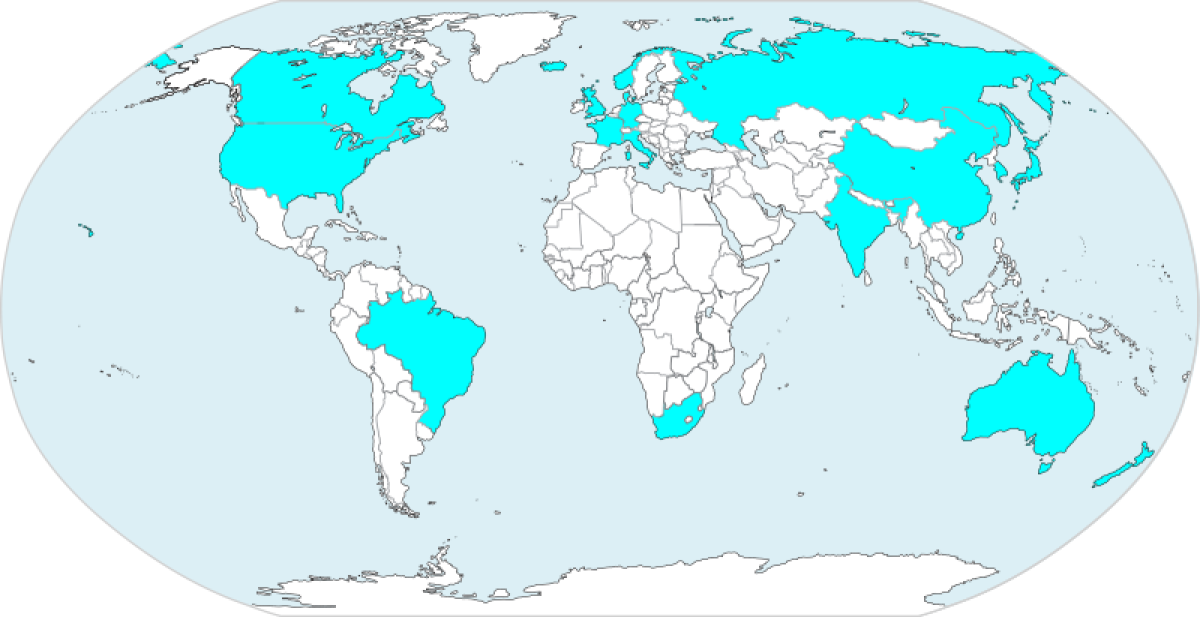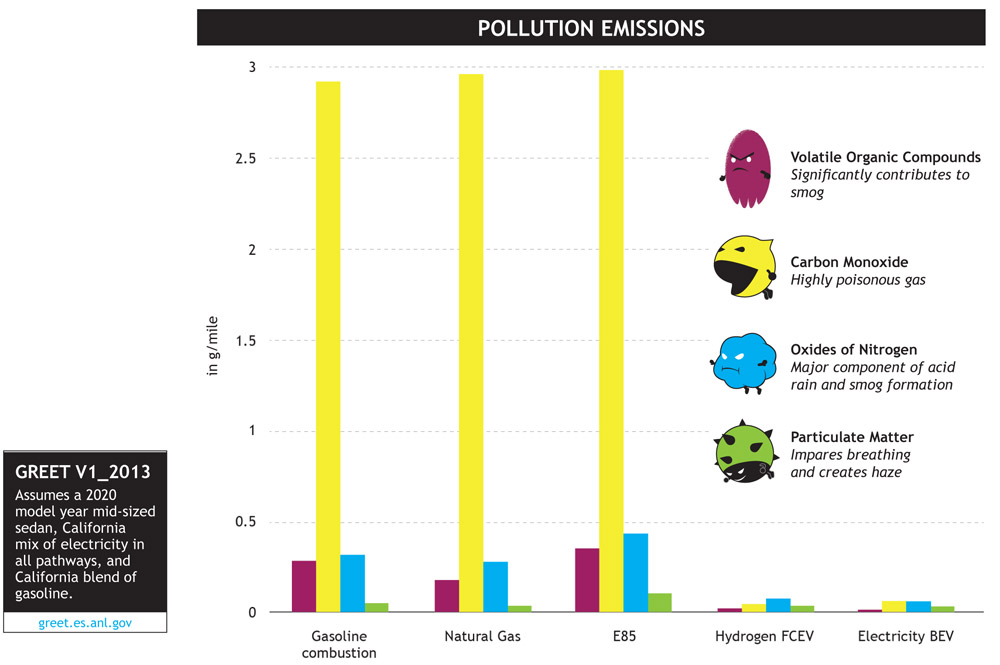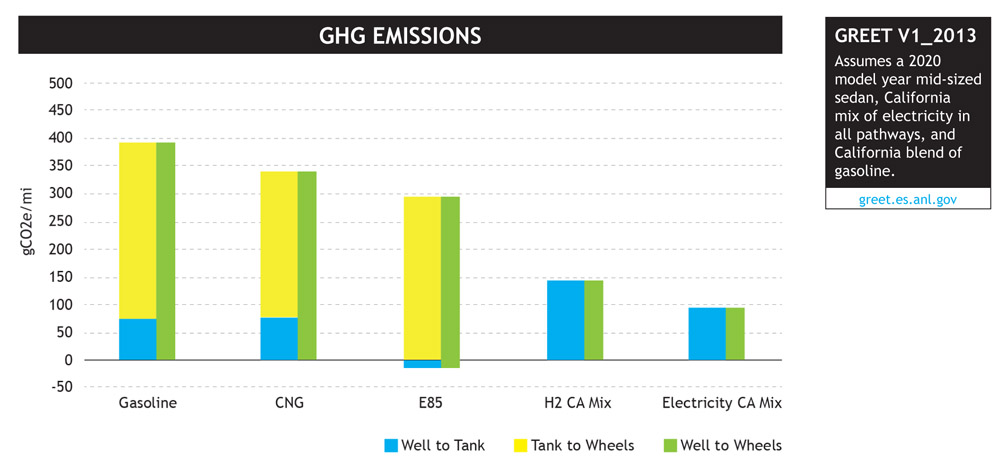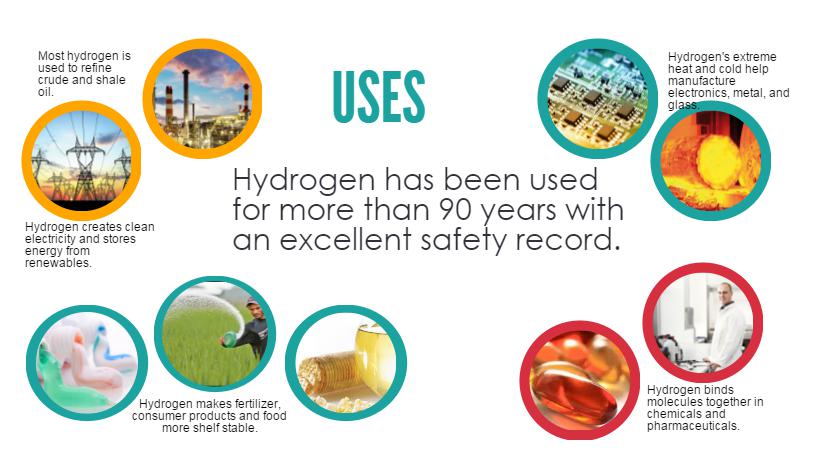Locations
Go where you want to go! The coordinated deployment of hydrogen stations across the state is providing the freedom to travel. Most stations are clustered in urban areas where driving a few miles can take 20 minutes. Stations in destination locations like Santa Barbara, Napa and Truckee mean weekend getaways with your FCEV. And the station in Coalinga means you can take a zero-emission trip from San Francisco or Sacramento to Los Angeles with a five-minute stop in the middle. This is just the beginning...
Refilling
It's as easy as 1-2-3.
- Swipe your credit card.
- Attach the nozzle and fill.
- Hang the nozzle back up.
Your car fills in about five minutes—easy, clean and safe. You're back on the road and ready for hundreds of miles before the next refueling stop.
Hydrogen is dispensed as a compressed gas. Most passenger vehicles use H70—compressed to 70 mPa—and larger vehicles use H35 (35 mPa). The station is a closed-loop system that meets national and international codes and standards.
Safety
Nothing drips, spills or stinks when you fill the tank with lighter-than-air hydrogen. Safety systems at the station and on the vehicle are designed for a buoyant, gaseous fuel.
Hydrogen, like every fuel, has specific properties and behaviors which are understood and used in the safe design and use of the fueling system. Designed and installed to safety codes and standards, a hydrogen station has several different safety systems that work together. If flame detectors or gas sensors detect a fire or significant leak, then safety systems automtically activate, isolating the storage tanks, stopping hydrogen flow or—in the case of an extreme fire—safely vent the hydrogen. Strategically placed emergency stops will manually shut down hydrogen equipment. Station developers work within internal safety and hazard mitigation protocols, the fire code, and with their local authorities to maximize station safety.
MAKING HYDROGEN
Hydrogen is all around us, but bound to other molecules—CH4, H2O, C2OH6. Producing hydrogen means separating from other molecules—something that's done all day, every day for the last 90 years. Because H2 comes from so many sources, every region of the world can produce its own fuel, which leads to better energy security for everyone.

Most hydrogen is made by steam reforming natural gas. Its an efficient and cost-effective process process where CH4 reacts with high-temperature steam (H2O) in the presence of a catalyst to separate the hydrogen from other molecules

Some hydrogen is made by electrolysis; passing a current of renewable electricity (sun, wind, geothermal) through water. The H2 is stored and O2 released into the air.

A National Fuel Cell Research Center report shows that low-cost renewable hydrogen production in California is possible over the next decade with the right policy incentives.
Infrastructure

Countries across the world are deploying fuel cell cars, bus, trucks, trains and more as well as hydrogen fueling infrastructure. China, Germany, Japan and South Korea are in the forefront and other countries have followed them in releasing their own hydrogen road maps or strategies.
California is also in the forefront of fuel cell electric vehicle deployment, and the successes and lessons learned here contribute to deployment efforts around the globe.
In 2018, H2FCP released its 2030 vision, foreshadowing the strategy documents released by other countries. In early 2020, the U.S. Hydrogen Economy Road Map was released.
Countries across the world are deploying fuel cell cars, bus, trucks, trains and more as well as hydrogen fueling infrastructure. China, Germany, Japan and South Korea are in the forefront and other countries have followed them in releasing their own hydrogen road maps or strategies.
California is also in the forefront of fuel cell electric vehicle deployment, and the successes and lessons learned here contribute to deployment efforts around the globe.
In 2018, H2FCP released its 2030 vision, foreshadowing the strategy documents released by other countries. In early 2020, the U.S. Hydrogen Economy Road Map was released.
10 Facts about Hydrogen

Hydrogen is produced and transported across the US and around the world every day
Available
Hydrogen is safely transported through 700 miles of US pipelines and 70 million gallons of liquid hydrogen is transported annually by truck over US highways without major incident. NREL's HyDRA map displays sites of current and potential hydrogen production from renewables and natural gas.

Automakers include three years of hydrogen fuel with the sale or lease of a vehicle
Cost
The average price of hydrogen for a light-duty fuel cell electric vehicle (passenger car) in California is $16.51 per kilogram, according to the 2019 Joint Agency Report (p17). As more retail stations open and have higher utilization, the price per kilogram of hydrogen is projected to drop to ranges more competitive with the prices of gasoline. For example, in late 2019, the True Zero Oakland hydrogen station opened with three times the capacity of previous stations. It offers hydrogen at $13.11 per kilogram (tax included) due, in part, to the larger volume and other factors.
In addition, drivers of fuel cell electric cars are offered free fuel by automakers for three years, to bridge the time it takes the market to become more competitive with other fuel options.
Reports, studies, and white papers from the Hydrogen Council, NREL and Shell, among others, all point to reductions in the price of fuel and fueling infrastructure for various reasons (scaling up, standardization, etc.).
Hydrogen Council: Path to Hydrogen Competitiveness: A Cost Perspective
Shell: Hydrogen Refueling Station Cost Reduction Roadmap
Shell: Towards Competitive Refueling Infrastructure
NREL: Manufacturing competitiveness analysis for hydrogen refueling stations
BloombergNEF: Hydrogen Economy Outlook Key Messages
Please note: The information above pertains to hydrogen stations serving light-duty fuel cell electric vehicles (passenger cars) and, therefore, does not reflect the cost or price of hydrogen for buses, trucks or any other fuel cell electric vehicle category.

Excess solar and wind energy that would normally be lost can be stored as hydrogen fuel
Storage
The wind blows and the sun shines even when power demand is low. Hydrogen is one way to store excess power.


Hydrogen is 14 times lighter than air
Buoyant
Hydrogen is the smallest element, with one proton and one electron. It has an average atomic weight of 1.0079 amu, making it the lightest element, and a density of 0.08988 g/L, making it less dense than air. Because of these properties, hydrogen is lighter than air and is impossible to pool or puddle in one place.

Outside of its container, hydrogen rapidly dissipates
Diffusive
Hydrogen is the most abundant chemical substance in the universe, especially in stars and gas giant planets. On Earth, hydrogen is a diatomic molecule (consists of two atoms) and it has a propensity to form covalent bonds with most elements. In other words, it hates to be by itself and will quickly bond with another molecule.

Every region of the world can create its hydrogen
Local
Because hydrogen can be made from so many sources, every region can use its own local resources to make fuel—vital in the quest for energy security.

Hydrogen is non-toxic, non-polluting and environmentally benign
Clean
At standard temperature and pressure, hydrogen is a nontoxic, nonmetallic, odorless, tasteless, and colorless. It will won't pool or puddle, pollute groundwater, ruin beaches or harm wildlife. It won't drip on your shoes, make your hands smell or make the asphalt slippery.

Zero air pollutants and reduced greenhouse gases
Emissions
Hydrogen production is a chemical reaction; using heat and catalysts to release hydrogen molecules from natural gas or biogas, or using solar or wind energy to electrolyze water.

The California mix of hydrogen, which requires 33% renewables, also reduces greenhouse gas emissions.

Read more on the Well to Wheels page.

Approximately 10-11 million metric tons of hydrogen are produced in the US each year
Plentiful
The Energy Information Agency reported that hydrogen production capacity at U.S. oil refineries is more than 3 million cubic feet a day. Enough hydrogen is produced now to power 20-30 million cars.
